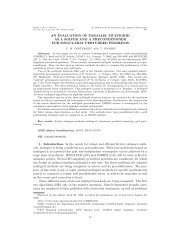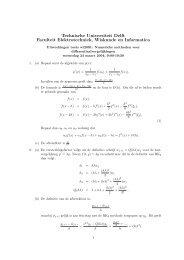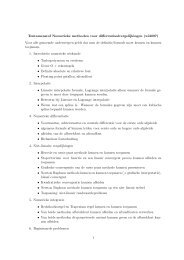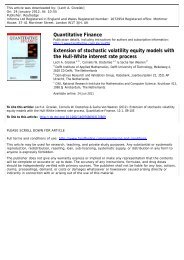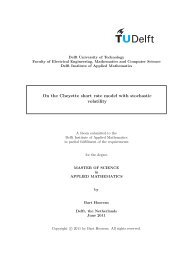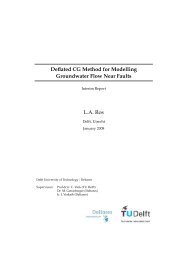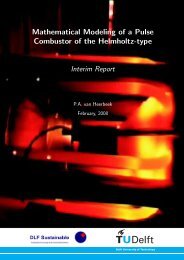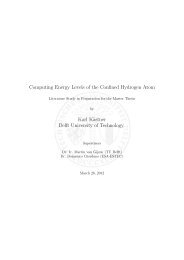Remark Unless stated otherwise, all implementations of the algorithms which were presentedin this Master <strong>Thesis</strong> and are used in numerical experiments, are written by us in Matlab.Also, if not mentioned, the machine used for tests is a Lenovo computer (Model R61) with aIntel(R) Core(TM)2 Duo CPU T5550 @ 1.83GHz and 2 GB of RAM.6.3 Region Growing AlgorithmWe start by using simple problems in which layers are regular and the same number of elements.We were able to set subdomains easily, by looking at the picture of the problem. Now, it isnatural to start working with more complicated examples. It is obvious, that the first thingwhich should be changed is the structure of the layer. Instead of having rectangular layers,which are parallel to each other, we consider problems in which the parts of the same materialtype have different shapes and sizes. Some of them may be embedded in other layers. Becauseof that, we need to have a tool, which we will use to recognize those areas inside the domain. Forthis purpose, we develop a Region Growing approach. However, we need additional informationabout the connectivity of Elements from the FEM discretisation, to be to perform in an efficientway.6.3.1 Region Growing 1.0 algorithmThe first approach to this issue, based on the available knowledge, was a direct, primitivealgorithm. Due to the fact, that at the beginning all we knew about the Element was whatkind of material it is made of, we could separate the set of all Elements into disjoint subsets ofElements of the same type. Next, we take the first Element, put it into an array and compareit with each of the other Elements from the same set. If the intersection of the indices of thedegrees of freedom was not empty, we know that they are connected with each other. So weput the checked Element into the array and remove it from the set. After that we check thenext one from the set till the last one. After that, we go the second Element in the array,and perform the procedure of comparing and removing from the set in a loop, until the pointwhen there was no expansion of the array in an iteration. This would mean, that all Elementsin the array are creating an area of the same material type, which is not connected with anyother Element of the same type. After this, if the subset of Element with the same materialtype were still non empty, then we would perform the procedure again, as described above, tillthe moment when there were no more Elements of the same type, which would be in the basesubset. Then we would go the next material type and do the same again etc.As we see, this algorithm is quite primitive, because in each loop it has to compare the chosenElement with all the Elements of the same material type, which for big problems can be aserious drawback. Actually we can come up with a simple example of a problem, in whichthe number of needed comparisons is at least (n−1)(n−2)2, where n is the number of Elements.If we consider Elements as nodes which are connected whenever the Elements share at leastone degree of freedom, then we will see that for a path graph [16] we will have to do exactly(n−1)(n−2)2calls of the comparing function, because the first node will need to be compared with(n−1) nodes, the second one with (n−2) and so on. By induction we can state that ultimatelywe will end up with (n−1)(n−2)2comparisons.However, we have an improved version of this algorithm, which works much faster.33
6.3.2 Region Growing 1.1 algorithmThe main difference, between the improved version and the original one lies in the change inthe comparison procedure. Rather then comparing in each outer loop, the degrees of freedom ofthe chosen Element with the Elements taken in the inner loop to see, whenever both Elementsare connected, we now remember each degree of freedom of Elements already included in thearray and compare them with the ones of the checked Element. This tightens up the wholeprocedure considerably, because in each call of the function we have already checked to see itif the Element is connected with any of the Elements from the area which are known at thistime.We also notice, that if an Element is connected with the area, then it is included to thearea, which means that the next Element which will be checked will be checked whenever itis also connected with the just included Element. Those two advantages makes this RegionGrowing algorithm a version which can and should be used instead of the first one.6.3.3 Region Growing 2.0 algorithmWe see that both algorithms do not use any information about the connectivity of the Elements,which implies that if we have two disjointed areas of the same material type, then whenwe "discover" the first one, we will always check all Elements from the second one, if theyare connected with it. This leads to the conclusion, that we will have plenty of unnecessaryfunction calls. Also if we manipulate the example used to show how many comparisons we needto perform, namely we would then change the enumeration, then we could end up again withthe same number.For that reason we decided to get more information about the Elements, to have a better algorithmfor recognition of the areas of the same material type. We receive information aboutthe neighbours of an Element. With this, we can now rewrite our algorithm to a form wherewe will not do any unnecessary calls function. Actually, our problem can now be seen, asfinding spanning trees in a graph, which is a well known problem in the Graph Theory and hasseveral algorithms for finding them. Because in our case each call of the function is regardedas the same in the sense of cost to perform it, we can easily choose for our problem the BFS(Breadth-first search) algorithm as the optimal tool.A spanning tree of a connected, undirected graph G, is a tree composed of its vertices. Formore information, see [15].We conclude this section with a table which shows the CPU time for each of the presentedalgorithms to find each area for Problem 6 [see Appendix 8.1]:AlgorithmVersion 1.0Version 1.1Version 2.0Time493.717990 seconds.5.24848 seconds0.673795 seconds.Table 6.1: CPU time for Region Growth AlgorithmsWe can find Matlab implementations of versions 1.1 and 2.0 in the Appendix (8.2).34




